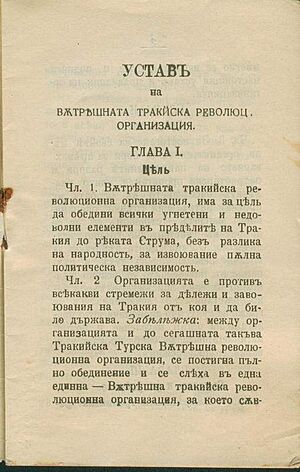Internal Thracian Revolutionary Organisation facts for kids
The Internal Thracian Revolutionary Organisation (ITRO) was a group of Bulgarian revolutionaries. They were active in a region called Thrace, which is now part of Greece and Bulgaria. This group worked between 1920 and 1934. Their main goal was to help Bulgarians living in Thrace.
Contents
What Was the ITRO?
The ITRO was formed because of a difficult situation for Bulgarians in Western Thrace. This area used to be part of Bulgaria. But in May 1920, it became part of Greece.
Why Was ITRO Formed?
After a big war in 1922, many Greek refugees moved into Greece. They settled in areas like Greek Macedonia and Western Thrace. To make homes for these refugees, the Greek government moved many Bulgarians from Western Thrace. They were sent to islands in the Aegean Sea.
These Bulgarians later returned home with help from the League of Nations. The League of Nations was an international group that worked for peace. But when the Bulgarians came back, they found their homes were taken by the Greek refugees.
This tough situation made the Bulgarians decide to fight back.
How ITRO Started and What They Did
The ITRO was created under the leadership of Tane Nikolov. He was a well-known leader from another revolutionary group. ITRO's groups started attacking Greek army posts in the region.
The organisation also worked with the Muslim people (Turks) in Western Thrace. They all wanted to create an "independent Thrace." This new Thrace would be watched over by the League of Nations. Their slogan was "Thrace for the Thracians." This meant they believed the people of Thrace should control their own land.
Changes and Challenges
By the end of 1922, the Greek government began sending many Bulgarians into Bulgaria. Because of this, ITRO's activities grew into a big rebellion. The organisation even took full control of some areas near the Bulgarian border.
However, in the summer of 1923, the Turks stopped working with ITRO. This happened after the Treaty of Lausanne, which protected the rights of Turks. By this time, most Bulgarians had already moved to Bulgaria.
In the same year, the Bulgarian government banned ITRO. Tane Nikolov then officially ended the group. But it was quickly started again by another leader named Dimitar Madzharov.
ITRO's Later Years
Even though ITRO groups still went into Western Thrace sometimes, their main focus changed. They started protecting the Bulgarians who had moved to Bulgaria. The organisation became very powerful in areas like Haskovo and Kurdzhali. Many refugees lived there. ITRO helped them settle down and even collected money from tobacco sellers.
The ITRO's activities started causing problems for the Bulgarian government with other countries. So, in 1927, ITRO was officially ended again. But it was immediately reformed under a new name: the Committee for Free Thrace. This committee continued until 1934. It was finally disbanded by the government of Kimon Georgiev.
See also
- Internal Macedonian Revolutionary Organisation
- Internal Dobrudjan Revolutionary Organisation
- Internal Western Outland Revolutionary Organisation



